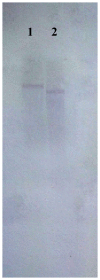Cloning and expression analysis of litchi (Litchi Chinensis Sonn.) polyphenol oxidase gene and relationship with postharvest pericarp browning
- PMID: 24763257
- PMCID: PMC3998928
- DOI: 10.1371/journal.pone.0093982
Cloning and expression analysis of litchi (Litchi Chinensis Sonn.) polyphenol oxidase gene and relationship with postharvest pericarp browning
Abstract
Polyphenol oxidase (PPO) plays a key role in the postharvest pericarp browning of litchi fruit, but its underlying mechanism remains unclear. In this study, we cloned the litchi PPO gene (LcPPO, JF926153), and described its expression patterns. The LcPPO cDNA sequence was 2120 bps in length with an open reading frame (ORF) of 1800 bps. The ORF encoded a polypeptide with 599 amino acid residues, sharing high similarities with other plant PPO. The DNA sequence of the ORF contained a 215-bp intron. After carrying out quantitative RT-PCR, we proved that the LcPPO expression was tissue-specific, exhibiting the highest level in the flower and leaf. In the pericarp of newly-harvested litchi fruits, the LcPPO expression level was relatively high compared with developing fruits. Regardless of the litchi cultivar and treatment conditions, the LcPPO expression level and the PPO activity in pericarp of postharvest fruits exhibited the similar variations. When the fruits were stored at room temperature without packaging, all the pericarp browning index, PPO activity and the LcPPO expression level of litchi pericarps were reaching the highest in Nandaowuhe (the most rapid browning cultivar), but the lowest in Ziniangxi (the slowest browning cultivar) within 2 d postharvest. Preserving the fruits of Feizixiao in 0.2-μm plastic bag at room temperature would decrease the rate of pericarp water loss, delay the pericarp browning, and also cause the reduction of the pericarp PPO activity and LcPPO expression level within 3 d postharvest. In addition, postharvest storage of Feizixiao fruit stored at 4°C delayed the pericarp browning while decreasing the pericarp PPO activity and LcPPO expression level within 2 d after harvest. Thus, we concluded that the up-regulation of LcPPO expression in pericarp at early stage of postharvest storage likely enhanced the PPO activity and further accelerated the postharvest pericarp browning of litchi fruit.
Conflict of interest statement
Figures







Similar articles
-
Polyphenol oxidase gene editing changed the flavonoid composition and browning process of litchi (Litchi chinensis Sonn.) callus.Gene. 2025 Feb 5;936:149130. doi: 10.1016/j.gene.2024.149130. Epub 2024 Nov 28. Gene. 2025. PMID: 39613050
-
Mitigating Oxidative Browning in Litchi by Regulating Biochemical Markers and Targeted Gene expression via Exogenous Nitric Oxide.Physiol Plant. 2025 Jan-Feb;177(1):e70107. doi: 10.1111/ppl.70107. Physiol Plant. 2025. PMID: 39953851
-
Delay of Postharvest Browning in Litchi Fruit by Melatonin via the Enhancing of Antioxidative Processes and Oxidation Repair.J Agric Food Chem. 2018 Jul 18;66(28):7475-7484. doi: 10.1021/acs.jafc.8b01922. Epub 2018 Jul 10. J Agric Food Chem. 2018. PMID: 29953220
-
Combinatorial approaches for controlling pericarp browning in Litchi (Litchi chinensis) fruit.J Food Sci Technol. 2015 Sep;52(9):5418-26. doi: 10.1007/s13197-015-1712-8. Epub 2015 Feb 11. J Food Sci Technol. 2015. PMID: 26344958 Free PMC article. Review.
-
Pericarp and seed of litchi and longan fruits: constituent, extraction, bioactive activity, and potential utilization.J Zhejiang Univ Sci B. 2019 Jun;20(6):503-512. doi: 10.1631/jzus.B1900161. J Zhejiang Univ Sci B. 2019. PMID: 31090276 Free PMC article. Review.
Cited by
-
An Intracellular Laccase Is Responsible for Epicatechin-Mediated Anthocyanin Degradation in Litchi Fruit Pericarp.Plant Physiol. 2015 Dec;169(4):2391-408. doi: 10.1104/pp.15.00359. Epub 2015 Oct 29. Plant Physiol. 2015. PMID: 26514808 Free PMC article.
-
Two New Polyphenol Oxidase Genes of Tea Plant (Camellia sinensis) Respond Differentially to the Regurgitant of Tea Geometrid, Ectropis obliqua.Int J Mol Sci. 2018 Aug 16;19(8):2414. doi: 10.3390/ijms19082414. Int J Mol Sci. 2018. PMID: 30115844 Free PMC article.
-
Exogenous melatonin delays oxidative browning in litchi during cold storage by regulating biochemical attributes and gene expression.Front Plant Sci. 2024 Jun 6;15:1402607. doi: 10.3389/fpls.2024.1402607. eCollection 2024. Front Plant Sci. 2024. PMID: 38903429 Free PMC article.
-
Characterization of the polyphenol oxidase gene family reveals a novel microRNA involved in posttranscriptional regulation of PPOs in Salvia miltiorrhiza.Sci Rep. 2017 Mar 17;7:44622. doi: 10.1038/srep44622. Sci Rep. 2017. PMID: 28304398 Free PMC article.
-
Identification and Expression Analysis of Polyphenol Oxidase Gene Family Members in Response to Wound Stress in Lettuce (Lactuca sativa L.).Plants (Basel). 2025 Mar 19;14(6):972. doi: 10.3390/plants14060972. Plants (Basel). 2025. PMID: 40265893 Free PMC article.
References
-
- Anderson JV, Fuerst EP, Tedrow T, Hulke B, Kennedy AC (2010) Activation of polyphenol oxidase in dormant wild oat caryopses by a seed-decay isolate of Fusarium avenaceum. Journal of agricultural and food chemistry 58: 10597–10605. - PubMed
-
- Kong JH, Sun QL, Tu YF, Chen XQ, Gao YP, et al. (2011) Research progress on enzymatic characteristic and application of polyphenol oxidase. Chinese Wild Plant Resources 30: 13–17.
-
- Liu L, Cao S, Xie B, Sun Z, Li X, et al. (2007) Characterization of polyphenol oxidase from litchi pericarp using (-)-epicatechin as substrate. Journal of agricultural and food chemistry 55: 7140–7143. - PubMed
-
- Jiang YM, Duan XW, Joyce D, Zhang ZQ, Li JR (2004) Advances in understanding of enzymatic browning in harvested litchi fruit. Food Chemistry 88: 443–446.
-
- Wang JB, Wang XS, Jin ZQ (2010) Enzymatic Browning of Postharvest Litchi: a Review. Acta Horticulturae 863: 613–618.
Publication types
MeSH terms
Substances
LinkOut - more resources
Full Text Sources
Other Literature Sources

